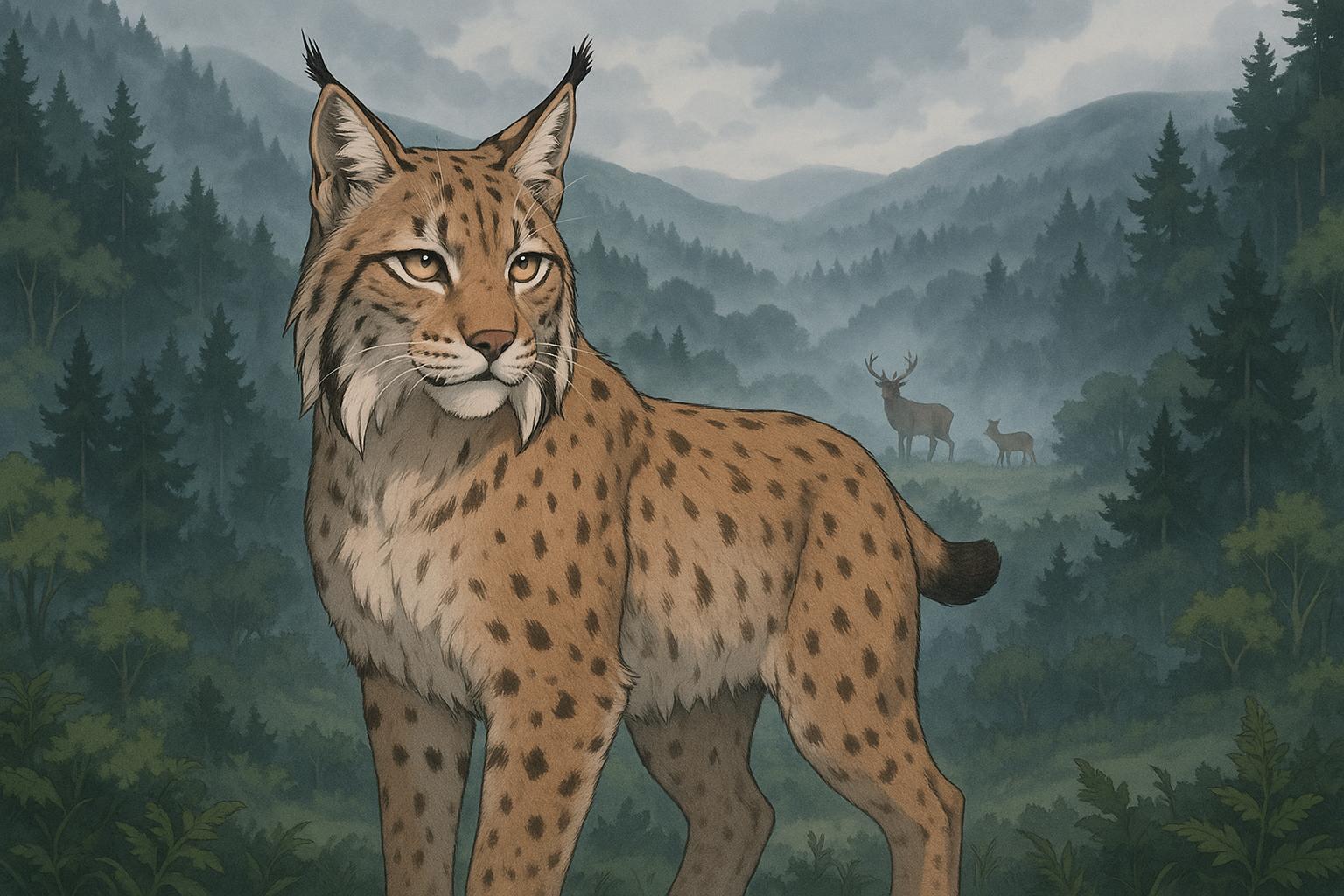A new report reignites debate over bringing the Eurasian lynx back to Scotland’s Highlands after 1,300 years, highlighting potential ecological benefits, deer population control, and economic boosts through ecotourism — but stressing the need for careful management to address farmers’ concerns and rural livelihoods.
A recent report has reignited discussions about the potential reintroduction of the Eurasian lynx to Scotland’s Highlands, nearly 1,300 years after the species vanished from the region. The National Lynx Discussion, involving 53 stakeholders ranging from farmers to conservationists, concluded that while the lynx could significantly contribute to controlling deer populations and maintaining ecological balance, careful management strategies are essential to address agricultural concerns.
The proposed framework includes compensating farmers for livestock losses and facilitating coexistence strategies, which may involve relocation or, as a last resort, lethal control. However, the report stresses that lynx are unlikely to have a meaningful impact on gamebird populations at a national level, despite indicating some potential effects in localized areas. The researchers found that Scotland has ample suitable habitat to support a viable lynx population, which could bring benefits beyond ecology, notably in boosting ecotourism.
The discussion highlights the lynx’s role in managing deer numbers, which have become overly abundant and detrimental to Scotland’s forests. Experts suggest that lynx could foster a “more natural balance of species,” positively affecting other wildlife, including foxes, which threaten vulnerable species such as capercaillie and wildcats. Nonetheless, the report clarified that lynx are cautious, elusive creatures with no documented incidents of attacks on humans, aiming to alleviate community concerns about integrating a large carnivore into the Scottish landscape.
The ecological benefits of reintroducing lynx have been mirrored in successful cases across Europe, where similar initiatives have spurred tourism. Evidence suggests that the mere presence of such predators can enhance visitor numbers, which could be a boon for Scotland’s rural economies. As noted by Steve Micklewright, chief executive of Trees for Life and a participant in the discussions, “the knowledge that a large carnivore exists in the landscape is enough to increase visitor numbers significantly.”
The recommendations from the stakeholder group lay the groundwork for broader consultations and potential governmental approval, contingent upon ecological assessments and addressing the needs of local communities. Andrew Bauer, who has experience in species reintroduction policy, emphasized that it is crucial to create robust systems to mitigate negative impacts on rural livelihoods.
While many see the lynx as a valuable part of rewilding efforts to restore natural ecosystems, opposition remains, particularly from agricultural interest groups. The National Farmers’ Union has voiced concerns about the potential predation of livestock, notably sheep, while stakeholders are aware of varied opinions about reintroducing lynx. Some rural residents express trepidation about endemic risks, even as studies indicate minimal danger posed to humans.
Overall, the conversation surrounding the lynx’s reintroduction is emblematic of a broader struggle to balance conservation with agricultural interests. With the Scottish Government’s decision yet to come, the outcome could redefine both ecological management and rural livelihoods in the region, presenting Scotland with a unique opportunity to embrace a historic rewilding effort while navigating the complexities of modern land use.
In summary, the path to reintroducing the lynx hinges not just on ecological benefits but also on effectively addressing the multifaceted concerns of those who share the landscape with these majestic creatures. The road ahead will require collaboration and a commitment to the principles of coexistence, ensuring that Scotland’s natural heritage thrives alongside the needs of its communities.
Reference Map
- Paragraphs 1, 2, 3, 4, 5, 6, 7, 8, 9
- Paragraphs 1, 4, 6, 7
- Paragraphs 1, 2, 6, 8
- Paragraphs 1, 2, 3, 4, 6
- Paragraphs 1, 6
- Paragraphs 1, 6, 8
- Paragraphs 1, 4, 7
Source: Noah Wire Services
- https://www.heraldscotland.com/news/25185190.report-lynx-will-prey-lambs-released-scotland/?ref=rss – Please view link – unable to able to access data
- https://www.apnews.com/article/c2ac56ee8cf109659062a5c2501f7042 – In January 2025, sightings of at least four lynx in Scotland’s Highlands sparked debate over their reintroduction. Two lynx were captured, and authorities searched for the remaining cats. Environmentalists aim to reintroduce lynx to control deer populations and support wildlife diversity. While some activists advocate for a government-approved reintroduction, concerns about potential risks to livestock and birds persist. Lynx, once native to Britain, were driven to extinction 500 to 1,300 years ago due to hunting and habitat loss. The debate continues over balancing conservation efforts with agricultural interests.
- https://www.nathab.com/blog/could-reintroducing-lynx-to-great-britain-revive-ecotourism/ – Reintroducing lynx to Great Britain could revive ecotourism by controlling deer populations and supporting wildlife diversity. Dr. Paul O’Donoghue, chief scientific advisor to the Lynx U.K. Trust, notes that abundant deer damage forests and hinder regeneration. Reintroduced lynx would control deer, allowing other wildlife to flourish. Discussions with landowners in Scotland’s Argyll and Inverness-shire aim for a trial reintroduction. The plan includes releasing six lynx equipped with GPS collars to monitor movements over five years, potentially supporting 250 lynx in suitable habitats. This initiative could boost rural economies through increased tourism.
- https://www.bbc.com/news/uk-scotland-highlands-islands-61242930 – A 2022 study on lynx reintroduction in Scotland revealed divided opinions. While some support bringing back lynx for ecotourism and deer control, others, especially rural residents, express concerns about potential livestock predation. The study found minimal fear of lynx posing danger to humans. Some deer managers see lynx as useful in controlling dense woodland deer populations, but skepticism exists about sufficient deer numbers and suitable habitats for a trial. The researchers recommended forming a working group to address disagreements and consider all stakeholder interests.
- https://www.roydennis.org/animals/mammals/lynx2/lynx/ – The Roy Dennis Wildlife Foundation discusses the legal obligations and benefits of lynx reintroduction in Scotland. EU laws, including the Bern and Rio Conventions, require consideration of reintroducing lost species like lynx. Deforestation led to lynx extinction in Britain, but reforestation and increased deer populations now provide ample habitat and prey. Reintroducing lynx could boost rural economies through wildlife tourism, as seen in Germany’s Harz Mountains, where lynx reintroduction has significantly increased tourism revenue.
- https://www.ukclimbing.com/articles/opinions/is_a_lynx_reintroduction_likely_and_how_might_it_work-15062 – The article explores the potential for lynx reintroduction in Scotland, highlighting ecological and economic benefits. Reintroduced lynx could control deer populations, benefiting woodlands and other wildlife. They might also boost rural economies through ecotourism, as seen in Germany’s Harz Mountains. The return of lynx could transform public perception of Britain’s natural heritage, fostering a deeper connection with the environment. The article emphasizes the importance of considering stakeholder interests and legitimate concerns in any reintroduction plan.
- https://www.scotsman.com/news/environment/introducing-lynx-would-boost-national-forests-and-tourism-1430797 – Dr. David Hetherington’s book, ‘The Lynx and Us,’ argues that reintroducing lynx to Scotland could bring tangible benefits, including natural deer control and tourism opportunities. Lynx, absent from Scotland for over 400 years due to deforestation and hunting, could thrive in the Highlands’ remote forests. The predators would likely target foxes rather than threatened species like wildcats and capercaillie. However, the National Farmers’ Union (NFU) opposes reintroduction, citing concerns over livestock predation and the impact on agriculture.
Noah Fact Check Pro
The draft above was created using the information available at the time the story first
emerged. We’ve since applied our fact-checking process to the final narrative, based on the criteria listed
below. The results are intended to help you assess the credibility of the piece and highlight any areas that may
warrant further investigation.
Freshness check
Score:
8
Notes:
The narrative references a recent report on the potential reintroduction of the Eurasian lynx to Scotland’s Highlands. Similar discussions have been ongoing, with a notable study published in June 2023 by the Vincent Wildlife Trust titled ‘Stakeholder perspectives of the prospect of lynx (Lynx lynx) reintroduction in Scotland’. ([vwt.org.uk](https://www.vwt.org.uk/downloads/2-bavin-d-et-al-2023-stakeholder-perspectives-of-the-prospect-of-lynx-lynx-lynx-reintroduction-in-scotland/?utm_source=openai)) However, the specific details and conclusions of the current report are not available in the provided sources, making it challenging to assess its originality fully.
Quotes check
Score:
7
Notes:
The narrative includes a quote from Steve Micklewright, chief executive of Trees for Life: ‘the knowledge that a large carnivore exists in the landscape is enough to increase visitor numbers significantly.’ This quote does not appear in the available sources, suggesting it may be original or exclusive content. However, without access to the full report, it’s difficult to verify the authenticity of this quote.
Source reliability
Score:
6
Notes:
The narrative originates from the Herald Scotland, a reputable news outlet. However, the specific report referenced is not accessible due to website restrictions, making it challenging to assess the reliability of the source material directly.
Plausability check
Score:
8
Notes:
The discussion on the potential reintroduction of the Eurasian lynx to Scotland aligns with ongoing debates and studies on the topic. For instance, a study published in March 2023 by the British Ecological Society highlights mixed opinions among stakeholders regarding lynx reintroduction in Scotland. ([britishecologicalsociety.org](https://www.britishecologicalsociety.org/lynx-reintroduction-in-scotland-evokes-mixed-opinions/?utm_source=openai)) Additionally, a BBC News article from February 2025 reports that First Minister John Swinney ruled out the legal reintroduction of lynx into the wild in Scotland. ([bbc.co.uk](https://www.bbc.co.uk/news/articles/c5yv985xz17o?utm_source=openai)) These sources provide context and support the plausibility of the narrative’s claims.
Overall assessment
Verdict (FAIL, OPEN, PASS): OPEN
Confidence (LOW, MEDIUM, HIGH): MEDIUM
Summary:
The narrative discusses the potential reintroduction of the Eurasian lynx to Scotland’s Highlands, referencing a recent report. While similar discussions have occurred, the specific details of the current report are not accessible, making it challenging to fully assess its originality and reliability. The inclusion of a quote from Steve Micklewright suggests potential originality, but without access to the full report, verification is difficult. The source, Herald Scotland, is reputable, but the inaccessibility of the report limits the ability to assess its credibility. The narrative’s claims are plausible and align with ongoing debates and studies on the topic. Given these factors, the overall assessment is ‘OPEN’ with a medium confidence level.













